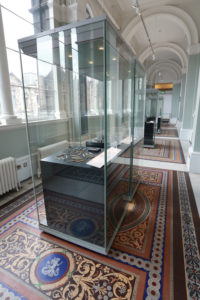 National Museums Scotland has successfully raised the £1.98 million ($2,550,000) necessary to acquire the Galloway Hoard. Half of the money will be given to metal detectorist Derek McLennan, who discovered the hoard in a field in Dumfries and Galloway, Scotland, in 2014, as an ex gratia payment in accordance with the terms of the Treasure Act which awards finders of artifacts adjudicated to be treasure a cash sum equivalent to their market value as an incentive to disclosing these kinds of discoveries instead of looting them for secret resale or to keep for themselves. The other half will go to the landowners, the Church of Scotland, which will dedicate its share to the local parish in which the treasure was found.
National Museums Scotland has successfully raised the £1.98 million ($2,550,000) necessary to acquire the Galloway Hoard. Half of the money will be given to metal detectorist Derek McLennan, who discovered the hoard in a field in Dumfries and Galloway, Scotland, in 2014, as an ex gratia payment in accordance with the terms of the Treasure Act which awards finders of artifacts adjudicated to be treasure a cash sum equivalent to their market value as an incentive to disclosing these kinds of discoveries instead of looting them for secret resale or to keep for themselves. The other half will go to the landowners, the Church of Scotland, which will dedicate its share to the local parish in which the treasure was found.
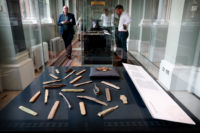 The Galloway Hoard was assessed by the valuation committee at such a large sum because it is the richest Viking hoard ever discovered in Britain. It includes silver jewelry, silver and gold ingots, a unique gold bird-shaped pin, a lidded silver-gilt pot, arm rings, brooches, a solid silver cross pendant decorated in enamel with the images of the Four Evangelists, bejeweled aestels (manuscript pointers), glass and crystal beads, a rock crystal jar and much more. Besides the sheer quantity and quality of the precious objects in the hoard, they are without parallel in the different places and cultures they came from. The rock crystal jar is believed to have been made in the Middle East; the lidded pot is Carolingian; the glass beads are Scandinavian; the stamp-decorated bracelets are Irish;
The Galloway Hoard was assessed by the valuation committee at such a large sum because it is the richest Viking hoard ever discovered in Britain. It includes silver jewelry, silver and gold ingots, a unique gold bird-shaped pin, a lidded silver-gilt pot, arm rings, brooches, a solid silver cross pendant decorated in enamel with the images of the Four Evangelists, bejeweled aestels (manuscript pointers), glass and crystal beads, a rock crystal jar and much more. Besides the sheer quantity and quality of the precious objects in the hoard, they are without parallel in the different places and cultures they came from. The rock crystal jar is believed to have been made in the Middle East; the lidded pot is Carolingian; the glass beads are Scandinavian; the stamp-decorated bracelets are Irish; 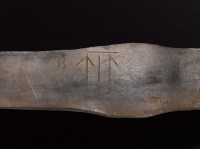 one of the silver pieces is engraved with runes at first thought to be Scandinavian but have been found upon closer examination to be Anglian. The ages of the objects vary significantly as well. The hoard was buried in the early 10th century, but the Carolingian pot was at least a century old by then, so it was likely kept as an heirloom for several generations before being used to hold the treasures it still contained a thousand years later.
one of the silver pieces is engraved with runes at first thought to be Scandinavian but have been found upon closer examination to be Anglian. The ages of the objects vary significantly as well. The hoard was buried in the early 10th century, but the Carolingian pot was at least a century old by then, so it was likely kept as an heirloom for several generations before being used to hold the treasures it still contained a thousand years later.
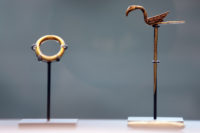 Some of the greatest of the treasures found inside the vessel are of little pecuniary but inestimable archaeological value. They are the remains of textiles that survived wrapped around several of the pieces stored inside the vessel and around the pot itself, plus leather and wood fragments. These exceedingly rare surviving organic materials, never found before in a hoard of this age, contain a wealth of information about the Viking Age, its travel and trade routes. They’re also a major conservation challenge, which is one of the reasons the Galloway Hoard was not allocated to a Galloway museum. NMS has the resources, expertise and carefully controlled conservation environment to ensure the continued survival organic remains.
Some of the greatest of the treasures found inside the vessel are of little pecuniary but inestimable archaeological value. They are the remains of textiles that survived wrapped around several of the pieces stored inside the vessel and around the pot itself, plus leather and wood fragments. These exceedingly rare surviving organic materials, never found before in a hoard of this age, contain a wealth of information about the Viking Age, its travel and trade routes. They’re also a major conservation challenge, which is one of the reasons the Galloway Hoard was not allocated to a Galloway museum. NMS has the resources, expertise and carefully controlled conservation environment to ensure the continued survival organic remains.
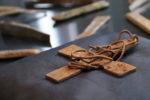 The hoard has been on temporary display at the National Museums Scotland in Edinburgh since the summer. The exhibition just closed on October 1st, but fear not, the treasures will be back in public view after a period of conservation and study. Here is Martin Goldberg, curator of the museum’s Early Medieval and Viking collections, guiding viewers through the exhibition and some of the objects from the Galloway Hoard.
The hoard has been on temporary display at the National Museums Scotland in Edinburgh since the summer. The exhibition just closed on October 1st, but fear not, the treasures will be back in public view after a period of conservation and study. Here is Martin Goldberg, curator of the museum’s Early Medieval and Viking collections, guiding viewers through the exhibition and some of the objects from the Galloway Hoard.
Yes, I am repeating myself, but the runes on that silver ingot were indeed inscribed by Anglian Saxon ‘Quality Controllers’ (til=apt, good for anything), and “Derek McLennaꝥes mildheortnyss is til mancynne” 😎
Ahem. “The Treasure Act 1996 is an Act of Parliament designed to deal with finds of treasure in England, Wales and Northern Ireland.” So it doesn’t apply in Galloway which is subject to Scots Law.
I’m no archaeologist or detectorist, but reading The Observer article today about the restored silver cross from the Galloway Hoard, and looking at the original cross covered in mud, it seems to me that they have removed the enamel, which is mentioned as being present on the cross when discovered. Am I correct with my assumption?